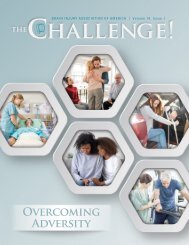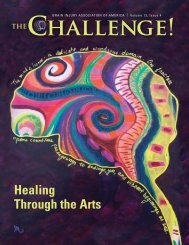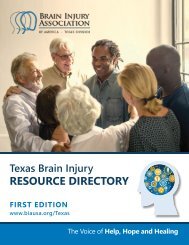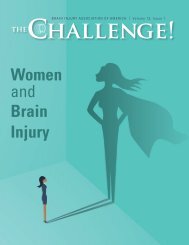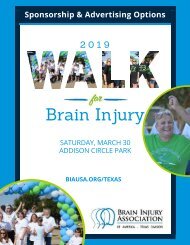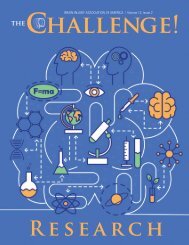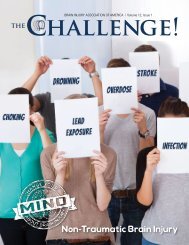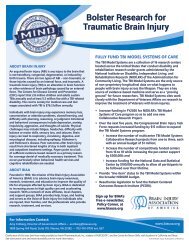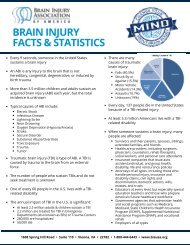THE Challenge 2019 Vol. 13 Iss. 3 Finding Cures for Brain Injury
Finding Cures for Brain Injury
Finding Cures for Brain Injury
You also want an ePaper? Increase the reach of your titles
YUMPU automatically turns print PDFs into web optimized ePapers that Google loves.
High quality PCPO programs use evidence-based<br />
interventions, that is, interventions that have been found<br />
to be effective by the best scientific evidence available.<br />
Research to establish the effectiveness of interventions<br />
controls <strong>for</strong> nonspecific effects, also known as placebo<br />
effects, like belief or expectation on the part of the<br />
therapist or the participant that the intervention will<br />
be effective. However, in clinical work, good therapists<br />
who are using methods that have scientific support also<br />
make the most of nonspecific effects and work to help<br />
participants feel motivated and successful and to look<br />
<strong>for</strong>ward to therapy. A positive therapeutic alliance can<br />
create a powerful nonspecific effect.<br />
Good therapists also encourage the participation of<br />
family and close others to the degree that is com<strong>for</strong>table<br />
<strong>for</strong> the participant. Close others provide emotional<br />
support <strong>for</strong> participants and help rein<strong>for</strong>ce participants<br />
in practicing skills learned in therapy in their daily life.<br />
A participant’s brain injury and rehabilitation are<br />
also often stressful <strong>for</strong> his or her close others. These<br />
individuals may need support, including psychological<br />
or family therapy if the stress and distress is severe.<br />
From the very beginning of therapy, the rehabilitation<br />
team plans with participants and their close others<br />
<strong>for</strong> transferring skills learned in therapy to real life<br />
and maintaining gains after discharge. Such ef<strong>for</strong>ts<br />
often include independent living trials and trials of<br />
work or school. Post-discharge planning often involves<br />
assisting the participant to engage with other sources<br />
of environmental and social support in addition to<br />
close others. The discharge plan also typically includes<br />
a schedule <strong>for</strong> follow-up by rehabilitation providers to<br />
make sure progress made in rehabilitation is maintained<br />
with an option <strong>for</strong> further rehabilitation if gains are<br />
being lost.<br />
PCPO finds its roots in the early work of brain injury<br />
rehabilitation pioneers and is also reflected in more<br />
contemporary approaches like Cognitive Orientation<br />
to daily Occupational Per<strong>for</strong>mance (CO-OP). The<br />
principles of PCPO described here are currently used<br />
in residential, outpatient, and community-based<br />
post-hospital brain injury rehabilitation programs in<br />
the United States and other countries as well as in the<br />
U.S. Veterans Administration.<br />
www.biausa.org 11




